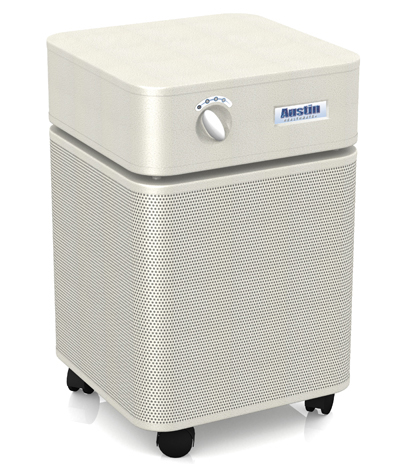Much has been written about the Coronavirus and the need for high standards of hygiene to prevent its transmission. Little has been written about air cleaners and the role they may play in preventing the spread of respiratory infection and illness, while also limiting the incidence of allergies and asthma.
Airborne particles are commonly either biological contaminants, particulate contaminants, gaseous contaminants, or dust. This diagram shows the size distribution in microns / micrometers / (μm) of various types of airborne particles.
SARS-CoV-2 is a variant of the coronaviridae family with a spherical diameter approximately 0.125 microns (125 nm).1 The diameter range of coronavirus particles is 0.06 to 0.14 micron (60 -140 nm).2 The virus can become airborne with coughing, sneezing, shouting, loud talking, or singing.
It travels from the COVID-19 carrier into the air in water droplets, mucous and aerosols.3 The CDC recommends that healthcare workers wear surgical N95 masks to protect them from exposure to the coronavirus COVID- 19.4 These masks provide 95% particle filtration to 0.3 micron (a micron is 1/1,000th of a millimeter or about 1/25,000 inch / 0.00004 inch).5
HEPA (High Efficiency Particulate Air) media is the highest standard of particle filtration.6,7 This standard was set by the Atomic Energy Commission during World War II.7 Back then, the standard was 97% particle removal up to 0.1 micron (micron) and 99.97% removal of particles up to 0.3 micron.8,9
According to more recent NASA research, HEPA media filters nanoparticles (0.01< micron sized particulate matter). This suggests that HEPA air filters may be useful in residential and professional settings where there is exposure to biologics such as viruses and bacteria. “When used alone, HEPA-rated media provides superior performance for removing virtually 100% of particulates.”10 “…if there are virus particles in the air entering a purifier, the HEPA filter will filter them out.”11
There are different grades of HEPA and the following Austin Air cleaners use Medical Grade HEPA filter material that may meet your needs.
Austin Air® HealthMate Plus® (HM450) Austin Air cleaner with over 780 cubic inches of Activated Carbon Impregnated with Potassium Iodide (a chemisorber) and Zeolite that removes Volatile Organic Compounds (VOCs), mercury, formaldehyde, benzenes, over 3000 chemicals, odors, and gases with 60 sq. ft. of True Medical HEPA filter material that removes microorganisms (bacteria and viruses) and other allergens from the air.
HealthMate Austin Air® (HM400) air cleaner with over 780 cubic inches of Activated Carbon and Zeolite that removes chemicals, gases, and odors / Zeolite with 60 sq. ft. of True Medical HEPA filter material filter material that removes microorganisms bacteria and viruses) and other allergens from the air.
Be wary of air purifiers that utilize non-HEPA technology that can release toxic ozone gases.12 Ozone can combine with common emissions found in our room air to produce adverse health effects. These gases can be especially harmful for asthmatics, children and the elderly.
Protect your patients and do your lungs a favor: Breathe easier!
Contact David at The Air Cleaner Store at (877)-432-1247 to provide you with right air cleaner at the best price for your air cleaner needs.
- Coronaviruses: An Overview of Their Replication and Pathogenesis Accessed April 1, 2020. Available at: https://www.ncbi.nlm.nih.gov/pmc/articles/PMC4369385/
- Can Masks Capture Coronavirus Particles? Accessed April 2, 2020. Available at: https://smartairfilters.com/en/blog/can-masks-capture-coronavirus/
- WHO Reviews ‘Current’ Evidence On Coronavirus Transmission Through Air. Accessed April 1, 2020. Available at: https://www.npr.org/2020/03/28/823292062/who-reviews-available-evidence-on-coronavirus-transmission-through-air
- NIOSH-Approved Particulate Filtering Facepiece Respirators. Accessed April 1, 2020. Available at: https://www.cdc.gov/niosh/npptl/topics/respirators/disp_part/default.html
- Micrometre. Accessed April 1, 2020. Available at: https://en.wikipedia.org/wiki/Micrometre
- HEPA. Accessed April 1, 2020. Available at: https://en.wikipedia.org/wiki/HEPA
- What is a HEPA filter? Accessed April 1, 2020. https://www.epa.gov/indoor-air-quality-iaq/what-hepa-filter-1
- Particle Size for Greatest Penetration of HEPA Filters and Their True Efficiency. Accessed April 1, 2020. Available at: https://www.osti.gov/servlets/purl/6241348
- HEPA Filters and ULPA Filters Information. Accessed April 1, 2020. Available at: https://www.globalspec.com/learnmore/manufacturing_process_equipment/filtration_separation_products/hepa_filters_ulpa_filters
- Submicron and Nanoparticulate Matter Removal by HEPA-Rated Media Filters and Packed Beds of Granular Materials. Accessed April 1, 2020. Available at:
https://ntrs.nasa.gov/archive/nasa/casi.ntrs.nasa.gov/20170005166.pdf - Can Air Purifiers Filter Out the Coronavirus? Accessed April 1, 2020. Available at: https://smartairfilters.com/en/blog/can-air-purifiers-remove-filter-out-covid/
- Hazardous Ozone-Generating “Air Purifiers.” Accessed April 1, 2020. Available at: https://ww2.arb.ca.gov/our-work/programs/air-cleaners-ozone-products/hazardous-ozone-generating-air-purifiers
Austin Air®, HealthMate®, and HealthMate Plus® are the registered trademarks of Austin Air Systems, Limited. The Air Cleaner StoreTM is a trademark of Frome Physical Therapy.


